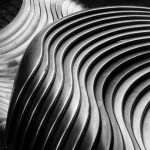PHOTOBOOK: VOLKSWAGEN – A WEEK AT THE FACTORY (1953)
by Peter Keetman | Part 3 of 5 : ‘Fenders & Bumpers’Trivia: These beautiful detailed studies of car parts and many other photos of Keetman’s week in Wolfsburg were rejected by Volkswagen publicists for being to abstract.
The German Economic Miracle, in which the German economy rose from the ashes of WWII, was in full bloom in 1953. Chancellor Konrad Adenauer became Time Magazine’s Man of the Year. Volkswagen had just completed its first year of producing over 100,000 Beetles. By 1965, they would be routinely manufacturing over one million annually.
The Beetle itself still retained the WWII-era 1.1-litre engine, and just a few weeks prior to Peter’s visit, received its most dramatic aesthetic change since its inception. In March of ’53 the original split rear-window was replaced by a one-piece oval window that would remain a hallmark of the Beetle for the following four and one-half years. (+)
Find the other 4 parts of this story here.
Tag: wolfsburg
PHOTOBOOK: VOLKSWAGEN – A WEEK AT THE FACTORY (1953)
by Peter Keetman | Part 5 of 5 : ‘Grinding & Stamping’Peter Keetman was a commercial and industrial photographer who has also published several books of landscape photography. In 1949, he was a founding member of Fotoform, a group of German photographers whose work meshed abstraction with objectivity, often incorporating close-ups and repetition. He has had one-man shows in Germany and the United States. Keetman died in 2005. (+)
Find the other 4 parts of this story here.

Kraftwerk, Wolfsburg, 1971

by Heinrich Heidersberger
VW Bad, Wolfsburg, 1961
by Peter Keetman
Volkswagen – A Week at the Factory, 1953, Part 1 of 5: The VW Car Park
One of the best-known and best-loved cars ever manufactured, the VW Bug was a symbol for decades of a casual lifestyle replete with breezy outings. But the 71 duotone photographs in this elegant paperbound volume offer a striking contrast to this populist impression.
In 1953, photographer Peter Keetman spent a week at a Volkswagen factory in Wolfsburg, Germany, emerging with a collection of remarkable images that, although rejected by the Volkswagen publicists, transform the parts of the popular car into works of abstract art gleaming stacks of hoods and fenders trace sinuous lines reminiscent of Edward Weston’s seashells; bolts of cable look like exotic plants; sheet metal takes on a life of its own.
Arranged in the order of the car’s manufacturing process, accompanied by three essays on photography and Volkswagen production, Volkswagen: A Week at the Factory is a landmark in the history of industrial photography and a timeless look at a contemporary icon. (+)
—Find the other 4 parts of this story here.—
(via burnedshoes)
by Peter Keetman
Photobook: Volkswagen – A week at the factory, 1953. Part 2 of 5: “The Assembly Line Blues”.
In April of 1953, German photographer Peter Keetman (1916-2005) spent a week at the Volkswagen factory in Wolfsburg. The images resulting from the Volkswagen project eventually became some of his favourite and best known.
When Herr Keetman visited, VW was at a pivotal point in its history. The Beetle and the Type II Transporter/Microbus were the only two products Volkswagen produced. However, a third model, the Karmann Ghia, had been developed and was little more than a year from introduction. The Wolfsburg plant was still VW’s only automobile manufacturing facility, but their second European assembly plant (Hanover) was in the planning stage, and Volkswagen do Brazil was in the process of beginning pilot production. (+)
–Find the other 4 parts of this story here.–
(via burnedshoes)





























